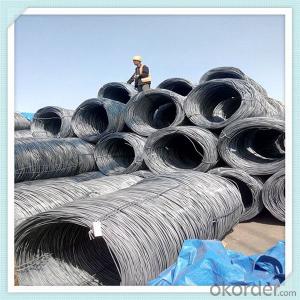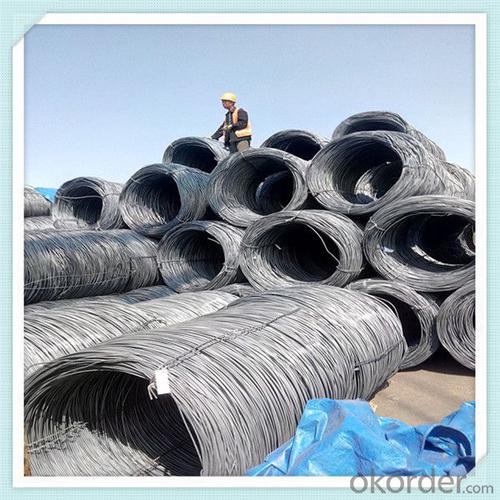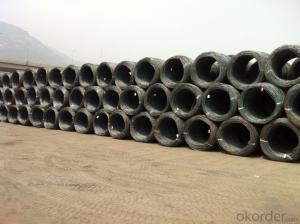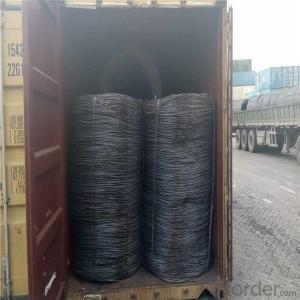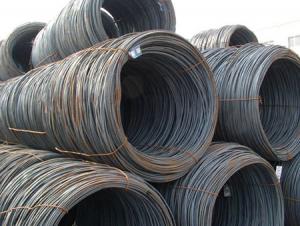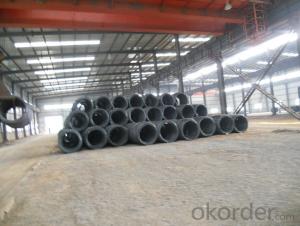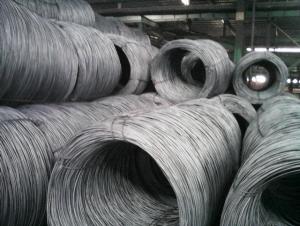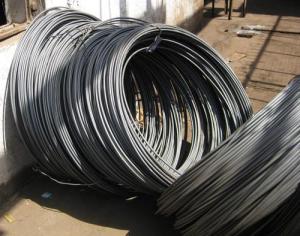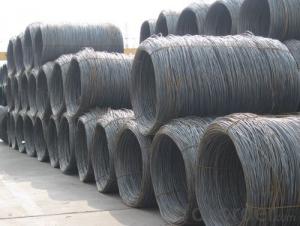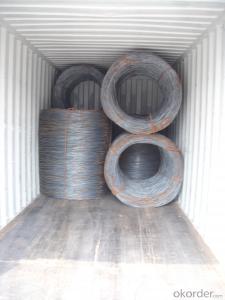SAE1008 low carbon steel wire rod different diameter
- Loading Port:
- China main port
- Payment Terms:
- TT OR LC
- Min Order Qty:
- 100 m.t.
- Supply Capability:
- 16592 m.t./month
OKorder Service Pledge
OKorder Financial Service
You Might Also Like
Specification
Wire rod is used for many different products. Depending upon how it is cold formed and heat treated, wire is used,
for example, to produce not only wire ropes, barbed wire, wire mesh and nails, but also springs, welded wire mesh
and reinforcement wire.
Our Advantage:
High quality steel products from 1 class mills in
Reasonable price
Professionalism of the products
On-time delivery
Complete documents and certificates
Sincere service to meet our clients' requirements
Features
1、Pure steel quality, stable chemical contents, small tolerance.
2、Constant Quality, good drawing performance.
3、High dimension accuracy degree, accuracy degree of Level C up to 80%, smooth surface, less scale,
easy to be pickled.
4、Automatic bundling with 4 lines by Machine in tidy and good looks
5、Big high quality percentage, small coil percentage, and heavy coil weight for Hard Coil.
6、High sorbitizing percentage.
Product Description :
Standard | AISI, ASTM, BS, DIN, GB, JIS |
Material/steel grade | Q195-Q235,SAE1006B,SAE1006CR, SAE1008B, SAE1008CR, SAE1010B, SAE1018B, or according to customers requirements |
Wire Gauge | 5.5-12mm |
Coil weight | 1.8-2.1mts |
MOQ | 25MT |
Delivery Time | 15-30 days after receipt of L/C or deposit by T/T |
Packing | In coil and load in container, if large quantity, by bulk vessel; Can be packed as customers' special requirements |
Payment terms | 1).100% irrevocable L/C at sight. 2).30% T/T prepaid and the balance against the copy of B/L. 3).30% T/T prepaid and the balance against L/C |
Application | widely used in machinery parts, manufacturing industry, electronics industry, metal tools and others |
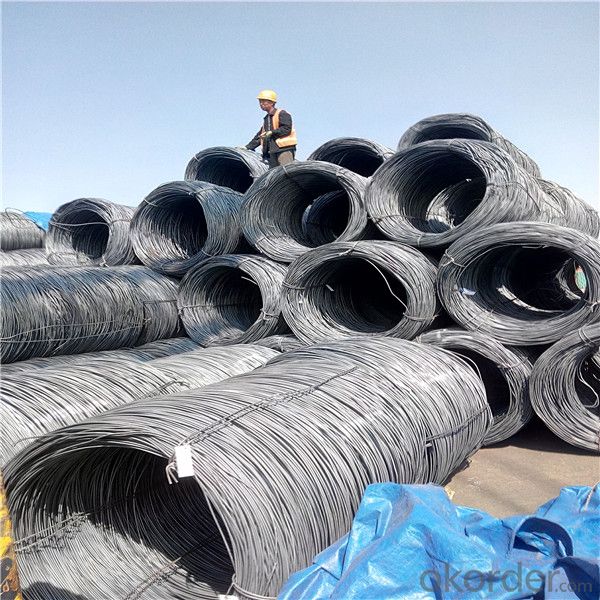
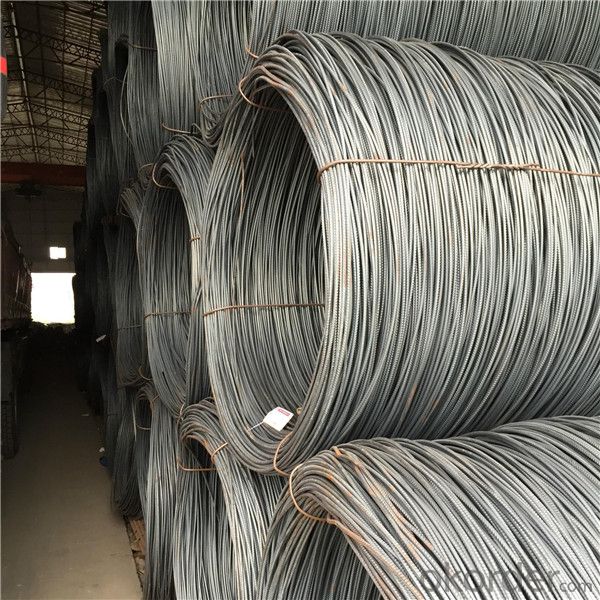
Application :
It generally used in braiding the hose for bathing product and machinery. With it
good flexibility, resistant to high temperature and resistant to corrosion, it
used widely in many industries.
Packing :
Hot-rolled wire rod is held in a unit with at least four steel straps in the
transverse direction and transported and stored without further packaging.
Before
the steel strapping is applied, the wire rod must be sufficiently compressed.
The strapping is fixed in the transverse direction with a single circumferential
strap so that the strapping does not slip and cause the coil to come apart.
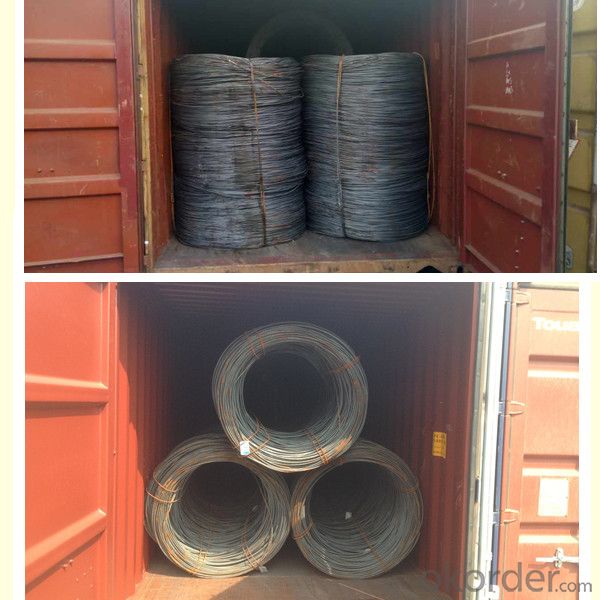
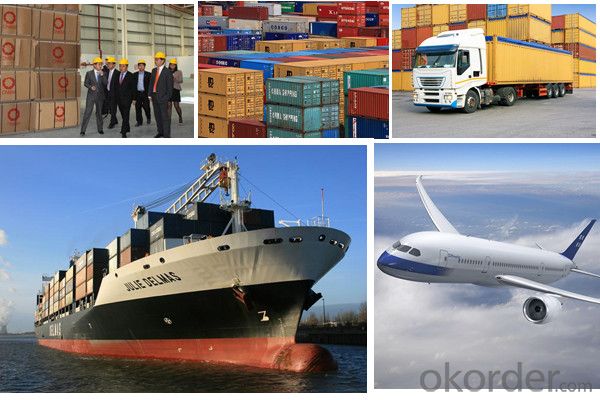
Our service:
(1) We cooperate with famous factories with advanced equipment and well trained workers.
(2) We can provide factory price with trading company service.
(3) We continuously work on the improvement of our processes, guaranteeing
consistently high standards of quality to keep none compensation.
(4) We guarantee 24 hours response and 48 hours solution providing service.
(5) We accept small order quantity before formal cooperation.
(6) We deliver the agreed quality at the agreed time, reacting to changes in
customer wishes in a flexible way.
(7) Due to our volume and selling power, we have excellent freight rates with
shipping lines.
(8) We strive to always be fair and honest in our dealings with customers.
(9) We strive to work together with customers to achieve much more than we can
achieve alone.
(10) Through our passion and commitment we aim to be a market leader in all our
key markets. To maintain our position as market leader we must continue to add
value in all that we do.
FAQ:
1.Q: What's your MOQ(minimum order quantity)?
A: One full container, mixed acceptable .
2. Q: What's your packing methods?
A: Packed in bundle or bulk ..
3. Q: How can I buy CNBM products in my country?
A:Please send us an inquiry or email ,we will reply to you if there is distributor in your country
4. Q: Can we visit your factory?
A: Warmly welcome. Once we have your schedule, we will arrange the
professional sales team to follow up your case.
5. Q: How long does it take to get the product if i place an order?
A:With the process of your requirements,we will pack and deliver in 3
-7 days. If it is by sea shipment,it will take 15-45 days depending on different locations
- Q: What are the different types of steel wire rod surface treatment processes?
- There are several different types of steel wire rod surface treatment processes that are commonly used in various industries. These processes are designed to enhance the properties and appearance of the steel wire rod, as well as to protect it from corrosion and other forms of damage. Here are some of the most commonly used surface treatment processes for steel wire rods: 1. Pickling: Pickling is a process that involves removing impurities, such as rust and scale, from the surface of the steel wire rod. This is typically done by immersing the wire rod in an acid solution, which dissolves the impurities and leaves the surface clean. 2. Phosphating: Phosphating is a process that involves coating the surface of the steel wire rod with a layer of phosphate. This layer provides corrosion resistance and acts as a base for subsequent surface treatments, such as painting or powder coating. 3. Galvanizing: Galvanizing is a process that involves coating the surface of the steel wire rod with a layer of zinc. This layer provides excellent corrosion resistance and can be applied through either hot-dip galvanizing or electroplating methods. 4. Electroplating: Electroplating is a process that involves depositing a thin layer of metal, such as zinc or chrome, onto the surface of the steel wire rod. This layer provides enhanced corrosion resistance and can also improve the appearance of the wire rod. 5. Coating: Coating is a process that involves applying a thin layer of protective material, such as paint or powder coating, onto the surface of the steel wire rod. This layer provides corrosion resistance and can also enhance the appearance of the wire rod. 6. Passivation: Passivation is a process that involves treating the surface of the steel wire rod with a chemical solution to remove any free iron or other contaminants. This process helps to prevent corrosion and improves the passive film on the surface of the wire rod. These are just a few of the many different types of surface treatment processes that can be used for steel wire rods. The specific process chosen will depend on the desired properties and requirements of the wire rod, as well as the intended application.
- Q: What are the different packaging options for steel wire rod?
- The different packaging options for steel wire rod include coils, spools, bundles, and crates.
- Q: What are the strength requirements for steel wire rod used in suspension bridge wire strands?
- The strength requirements for steel wire rod used in suspension bridge wire strands can vary depending on several factors. Generally, the wire rod must possess high tensile strength to withstand the immense loads and stresses that suspension bridges are subjected to. The wire rod must have a minimum yield strength and ultimate tensile strength that meets or exceeds the design requirements for the suspension bridge. The yield strength refers to the amount of stress that the wire rod can withstand before it begins to deform permanently, while the ultimate tensile strength indicates the maximum stress the wire rod can endure before it breaks. In addition to high strength, the wire rod must also exhibit good ductility and toughness. Ductility refers to the ability of the material to deform without fracturing, while toughness is its ability to absorb energy without fracturing. These properties are crucial for structural integrity as they allow the wire strand to flex and absorb dynamic loads, such as wind or vehicle vibrations, without failure. Furthermore, the wire rod should have excellent corrosion resistance to ensure the longevity and durability of the suspension bridge. Corrosion can weaken the wire strands over time, compromising the structural integrity of the bridge. Therefore, the wire rod must possess a protective coating or be made from corrosion-resistant alloys to withstand exposure to environmental factors such as moisture, saltwater, and pollutants. Finally, the dimensional requirements of the wire rod, including its diameter and surface finish, must also meet the specifications of the suspension bridge design. These dimensions are crucial for maintaining the desired strength and performance characteristics of the wire strands. In summary, the strength requirements for steel wire rod used in suspension bridge wire strands include high tensile strength, good ductility, toughness, corrosion resistance, and adherence to dimensional specifications. Meeting these requirements ensures the wire strands can withstand the significant loads and environmental conditions experienced by suspension bridges, ensuring their structural integrity and safety.
- Q: How is steel wire rod used in the manufacturing of wire for agricultural fencing?
- Steel wire rod is used in the manufacturing of wire for agricultural fencing by being drawn through a series of dies to reduce its diameter and increase its length. This process, known as wire drawing, results in a strong and durable wire that is then woven or welded into the desired fencing shape. The high tensile strength of steel wire rod ensures that the agricultural fencing can withstand the pressure and stress it may encounter in outdoor environments, making it an ideal material for securing livestock and crops.
- Q: How is steel wire rod used in the manufacturing of wire mesh strainers?
- Steel wire rod is used in the manufacturing of wire mesh strainers as the primary material for creating the mesh structure. The wire rod is drawn through a series of dies to reduce its diameter and increase its length. It is then woven or welded together to form a mesh pattern, which provides strength, durability, and the ability to filter out unwanted particles or debris when used as a strainer.
- Q: How is steel wire rod used in the manufacturing of wire forms for conveyor systems?
- Steel wire rod is used in the manufacturing of wire forms for conveyor systems by being shaped, cut, and bent into various forms such as hooks, rings, and clips. These wire forms are then integrated into the conveyor system to provide support, stability, and control for the movement of materials or products along the system. The high strength and durability of steel wire rod make it an ideal material choice for wire forms in conveyor systems, ensuring reliable and efficient operation.
- Q: What are the different types of steel wire rod coating materials?
- There are several different types of coating materials used for steel wire rods, each serving a specific purpose and offering different advantages. Some of the common types of coating materials include: 1. Zinc Coating: Zinc coating, also known as galvanizing, is one of the most widely used coatings for steel wire rods. It provides excellent corrosion resistance, protecting the wire from rust and other environmental factors. Zinc coating can be applied through hot-dipping or electroplating methods. 2. Phosphate Coating: Phosphate coating is often used as a pretreatment before applying other coatings or paints. It provides a base layer that enhances adhesion and improves corrosion resistance. Phosphate coatings are commonly used in industries such as automotive, construction, and agriculture. 3. Polymer Coating: Polymer coatings are applied to steel wire rods to provide additional protection against corrosion, abrasion, and other mechanical stresses. These coatings are often made of epoxy, nylon, or polyethylene materials, which offer excellent durability and resistance to chemicals and extreme temperatures. 4. Copper Coating: Copper coating is used to enhance the electrical conductivity of steel wire rods. It is commonly applied in the manufacturing of electrical wires and cables, where high conductivity is required. 5. Chrome Coating: Chrome coating is known for its high resistance to corrosion and wear. It is often applied to steel wire rods used in applications where they will be exposed to harsh environments or high temperatures. 6. Aluminum Coating: Aluminum coating provides a lightweight and corrosion-resistant layer to steel wire rods. It is commonly used in industries such as aerospace and automotive, where weight reduction and durability are crucial. 7. Organic Coating: Organic coatings, such as polyurethane or acrylic paints, are used to provide aesthetic appeal and protection against corrosion and UV rays. These coatings are often used in applications where the wire rods will be visible or subjected to outdoor conditions. It is important to select the appropriate coating material based on the specific requirements and intended use of the steel wire rods. Factors such as corrosion resistance, electrical conductivity, durability, and environmental conditions should be considered to ensure the optimal performance of the coated wire rods.
- Q: How does steel wire rod behave under different temperature conditions?
- Steel wire rod exhibits varying behavior depending on the temperature it is exposed to. When subjected to lower temperatures, the steel wire rod tends to become more fragile and susceptible to fractures. This is primarily because the cold temperatures cause the metal to contract, reducing its ability to stretch and making it more susceptible to breaking under stress. Conversely, when exposed to higher temperatures, the steel wire rod becomes more pliable and easier to bend or shape. This is a result of the metal expanding as it heats up, which increases its ability to stretch and allows it to endure greater deformation without fracturing. Nonetheless, it is essential to recognize that extreme temperatures can have adverse effects on the steel wire rod. In extremely low temperatures, such as those encountered in cryogenic environments, the steel may undergo a phase transformation referred to as the ductile to brittle transition, where it becomes exceedingly brittle and prone to abrupt failure. Likewise, at extremely high temperatures, the steel wire rod may experience a loss of strength and integrity, as the elevated temperatures can cause the metal to soften and deform. The precise temperature at which this phenomenon occurs depends on the specific type of steel and its composition. To summarize, the behavior of steel wire rod is influenced by the ambient temperature. It becomes more fragile and susceptible to fractures at lower temperatures, while it becomes more pliable and easier to shape at higher temperatures. However, extreme temperatures can have detrimental effects on the steel's properties, leading to brittleness at low temperatures and a loss of strength at high temperatures.
- Q: What are the major factors affecting the supply and demand of steel wire rod?
- There are several major factors that can affect the supply and demand of steel wire rod. 1. Economic growth: Economic growth plays a significant role in the demand for steel wire rod. When the economy is growing, there is increased construction activity, infrastructure development, and manufacturing output, all of which require steel wire rod. On the other hand, during economic downturns, demand for steel wire rod may decline as construction projects are put on hold and manufacturing activities slow down. 2. Global steel production: The global steel production capacity and output levels can impact the supply of steel wire rod. If there is an increase in steel production, there will be a larger supply of steel wire rod available in the market. Conversely, if steel production decreases due to factors such as trade restrictions or production disruptions, the supply of steel wire rod may be limited. 3. Raw material availability and prices: The availability and cost of raw materials used in steel wire rod production, such as iron ore and scrap metal, can impact the supply and pricing of steel wire rod. If the prices of these raw materials increase, it can lead to higher production costs for steel wire rod manufacturers, potentially reducing the supply or increasing the price of the product. 4. Technological advancements: Technological advancements in steel wire rod production processes can impact both the supply and demand. Improved production techniques can increase the supply by making the manufacturing process more efficient and cost-effective. Additionally, advancements in steel wire rod applications, such as in the automotive or construction industries, can increase the demand for the product. 5. Trade policies and tariffs: Trade policies and tariffs imposed by governments can have a significant impact on the supply and demand of steel wire rod. Tariffs on steel imports can limit the supply of steel wire rod from foreign producers, potentially increasing the demand for domestic manufacturers. Conversely, reduced trade barriers can increase competition and supply from global markets. 6. Environmental regulations: Environmental regulations and sustainability initiatives can also influence the supply and demand of steel wire rod. Stricter environmental regulations may require steel wire rod manufacturers to invest in cleaner production methods, potentially increasing production costs and limiting supply. Additionally, the demand for sustainably produced steel wire rod may increase as companies and consumers prioritize environmentally friendly products. Overall, the supply and demand of steel wire rod are influenced by a combination of economic factors, technological advancements, raw material availability, trade policies, and environmental considerations. These factors can fluctuate over time, leading to changes in the supply and demand dynamics of the steel wire rod market.
- Q: What are the main factors affecting the market mergers of steel wire rod?
- The main factors affecting the market mergers of steel wire rod include industry consolidation, market demand and competition, regulatory environment, technological advancements, and cost considerations.
Send your message to us
SAE1008 low carbon steel wire rod different diameter
- Loading Port:
- China main port
- Payment Terms:
- TT OR LC
- Min Order Qty:
- 100 m.t.
- Supply Capability:
- 16592 m.t./month
OKorder Service Pledge
OKorder Financial Service
Similar products
Hot products
Hot Searches
Related keywords
